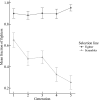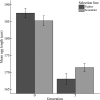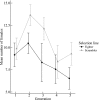Life-history consequences of bidirectional selection for male morph in a male-dimorphic bulb mite
- PMID: 30421131
- PMCID: PMC6280856
- DOI: 10.1007/s10493-018-0320-5
Life-history consequences of bidirectional selection for male morph in a male-dimorphic bulb mite
Abstract
Intralocus sexual conflict (IASC) arises when males and females have different trait optima. Some males pursue different alternative reproductive tactics (ARTs) with different trait optima, resulting in different strengths of IASC. Consequently, for instance daughter fitness is differentially affected by her sire's morph. We tested if-and which-other life-history traits correlatively change in bidirectional, artificial selection experiments for ARTs. We used the male-dimorphic bulb mite Rhizoglyphus robini, the males of which are high-fitness 'fighters' or low-fitness 'scramblers'. Twice in each of the five generations of selection, we assessed clutch composition (number of mites of the various life stages present) and size (total number of offspring). Furthermore, we tracked offspring from egg to adulthood in the first and final generation to detect differences between selection lines in the size and duration of stages, and in maturation time. We found that selection for male morph increased the frequency of that morph. Furthermore, compared to fighter lines, scrambler lines produced more females, which laid larger eggs (in the final generations), and maintained a higher egg-laying rate for longer. Otherwise, our results showed no consistent differences between the selection lines in clutch size and composition, life stage size or duration, or maturation time. Though we found few correlated life-history trait changes in response to selection on male morph, the differences in egg laying rate and egg size suggest that IASC between fighters is costlier to females than IASC with scramblers. We hypothesize that these differences in reproductive traits allow fighter-offspring to perform better in small, declining populations but scrambler-offspring to perform better in large, growing populations.
Keywords: ARP; Alternative reproductive phenotype; Major; Minor; Population dynamics; Sneaker.
Conflict of interest statement
The authors declare no conflict of interest.
Figures







Similar articles
-
Selection for alternative male reproductive tactics alters intralocus sexual conflict.Evolution. 2014 Jul;68(7):2137-44. doi: 10.1111/evo.12409. Epub 2014 Apr 16. Evolution. 2014. PMID: 24641007
-
Morph-specific artificial selection reveals a constraint on the evolution of polyphenisms.Proc Biol Sci. 2018 May 30;285(1879):20180335. doi: 10.1098/rspb.2018.0335. Proc Biol Sci. 2018. PMID: 29794046 Free PMC article.
-
Transcriptomics of Intralocus Sexual Conflict: Gene Expression Patterns in Females Change in Response to Selection on a Male Secondary Sexual Trait in the Bulb Mite.Genome Biol Evol. 2016 Aug 25;8(8):2351-7. doi: 10.1093/gbe/evw169. Genome Biol Evol. 2016. PMID: 27401174 Free PMC article.
-
Sexual selection and conflict in the bulb mite, Rhizoglyphus robini (Astigmata: Acaridae).Exp Appl Acarol. 2007;42(3):151-8. doi: 10.1007/s10493-007-9086-x. Epub 2007 Jul 5. Exp Appl Acarol. 2007. PMID: 17611805 Review.
-
Orchestration of avian reproductive effort: an integration of the ultimate and proximate bases for flexibility in clutch size, incubation behaviour, and yolk androgen deposition.Biol Rev Camb Philos Soc. 2006 Nov;81(4):629-66. doi: 10.1017/S1464793106007147. Epub 2006 Oct 12. Biol Rev Camb Philos Soc. 2006. PMID: 17038202 Review.
Cited by
-
Costs of weaponry: Unarmed males sire more offspring than armed males in a male-dimorphic mite.J Evol Biol. 2019 Feb;32(2):153-162. doi: 10.1111/jeb.13402. Epub 2018 Dec 3. J Evol Biol. 2019. PMID: 30422392 Free PMC article.
-
The role of genetic diversity in the evolution and maintenance of environmentally-cued, male alternative reproductive tactics.BMC Evol Biol. 2019 Feb 18;19(1):58. doi: 10.1186/s12862-019-1385-4. BMC Evol Biol. 2019. PMID: 30777004 Free PMC article.
References
-
- Baker GT. Observations on the morphology and biology of Rhizoglyphus robini Claparède (Acari, Acaridae) Corvallis: Oregon State University; 1982.
-
- Bates D, Mächler M, Bolker B, Walker S. Fitting linear mixed-effects models using lme4. J Stat Softw. 2015;67:1–48. doi: 10.18637/jss.v067.i01. - DOI
MeSH terms
Grants and funding
LinkOut - more resources
Full Text Sources
Miscellaneous

